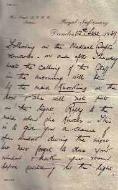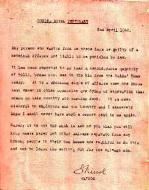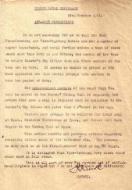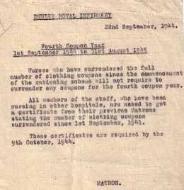Life in the Wards
The war had an immediate impact on daily life in the hospitals. The blackout had to be strictly observed at night - this was usually the responsibility of the nursing staff. Bunty Smith, Catherine Kinnear (now Mrs Turner) and Phyllis Allan (now Mrs Henniger) trained as nurses at Dundee Royal Infirmary 1940-44. They remember sitting on the roof of the Caird building looking out for enemy aircraft. If an air raid sounded, the children had to be taken down to the basement, while other patients were supposed to hide under their beds.
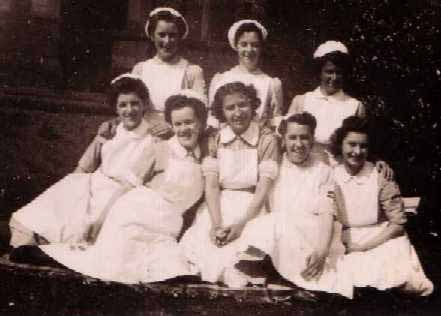
Nurses at Dundee Royal Infirmary (Courtesy of Bunty Smith)
Emergency medical supplies were ordered to meet the increased demand - the chemistry departments of University College Dundee and the Technical College helped with this. The main shortage was food, which was strictly rationed. "The food was very poor," recalls Bunty. "We had semolina nearly every day and we called it 365." Catherine remembered that "when we got through our exams we celebrated with an extra spoonful of sugar in our tea!" She also recalls that bananas were occasionally supplied to the children's ward - a real rarity in wartime.
Memos from Matron, Dundee Royal Infirmary - click on the images to see them full size
Due to staff shortages there were no cleaners in the hospital, so this had to be done by first year nurses (known as 'pinkies' because of their uniform). This extended to cleaning and straightening all the bed-wheels and polishing all the brass plaques. A strict code of conduct was observed among the staff - junior nurses were not allowed to speak to seniors unless spoken to first, and all nurses had to stand up if a doctor entered the ward.

Nurses at Bridge of Earn Hospital (Courtesy of the Riley family)
Many soldiers returned from the war suffering from shell-shock or other forms of mental distress. Two controversial treatments were introduced for patients suffering severe mental disorder - Electro-Convulsive Therapy (ECT) and the pre-frontal leucotomy (also known as lobotomy). In 1945, Westgreen Hospital in Dundee was publicly criticised for using ECT in open wards, in full view of other patients. At the outbreak of war, sulphonamide drugs for treating infections were still in their infancy. The British company May & Baker developed an early form called Prontosil, and 'M&B 693' went on to save many lives in the war, including Winston Churchill's when he contracted pneumonia. The most notable new treatment for infections, however, was penicillin. Due to its scarcity it was used only on wounded troops until increasing supplies allowed it to be extended to civilians, the first in Dundee being treated in November 1944. Mr Stanley Soutar, Assistant in the Surgical Department at DRI, had to take a special course of instruction before being allowed to use the new drug. As most local surgeons were on active service, Mr Soutar was on constant call and performed all emergency operations, except when relieved by another surgeon from 2-11pm on Tuesdays and Fridays!

Operating at Bridge of Earn Hospital - the chipped enamel basins are a clear
indication of wartime economies (Courtesy of the Riley family)
Tayside's hospitals also had to cope with a number of major epidemics during the war years. In 1941 over 4,000 were admitted to Kings Cross with diptheria, some 10% of these dying. There were 159 cases of meningococcal meningitis, but the new drug sulphapyridine (M&B 693) reduced the former fatality rate of 70% down to 16%. Later that year, an outbreak of paratyphoid affected 306 people (8 of whom died), caused by a batch of synthetic cream supplied to a Dundee firm of bakers. The wards at Kings Cross that accommodated these patients were subsequently used for scabies which was extremely common in Dundee at the time. 1944 saw the erection of the first proper isolation ward in Kings Cross for the treatment of certain infectious diseases. The Kings Cross Hospital Staff Concert Party is fondly remembered for its charity performances both in and out of hospital during the early years of the war.
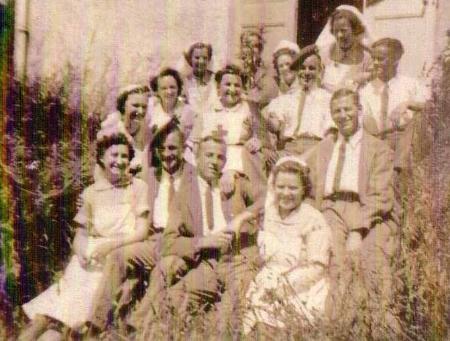
Soldiers recovering from war injuries at Ashludie, with nursing staff, c 1944
(Courtesy of Monifieth Local History Society)
Read what life was like as a patient at DRI and Rossie Priory during the war.
Next Page Previous Page
